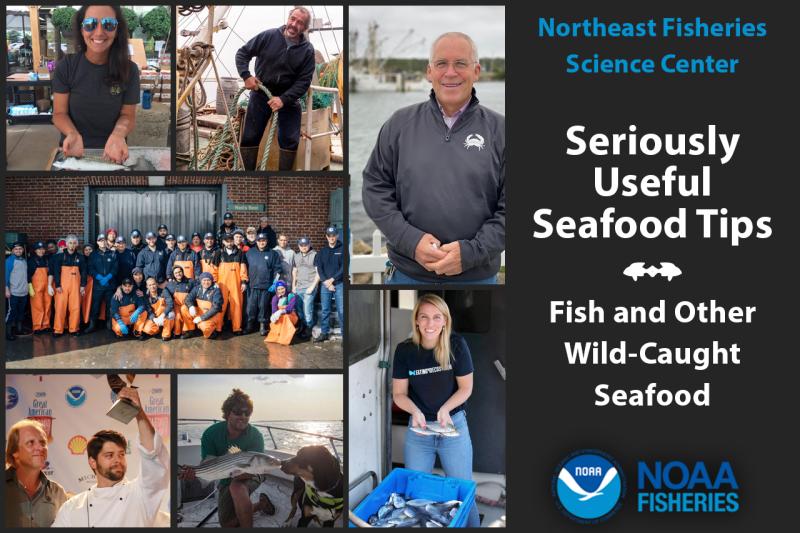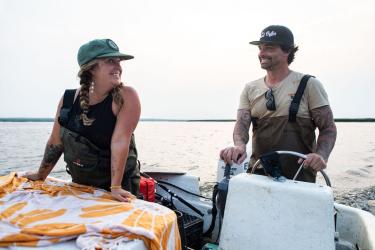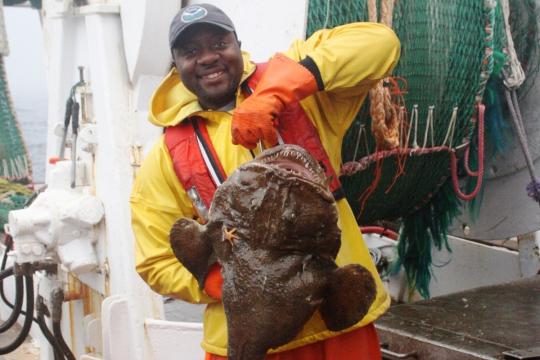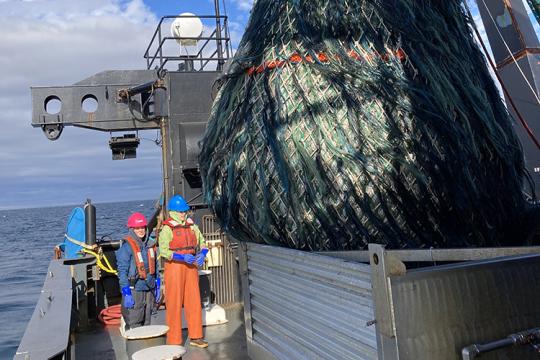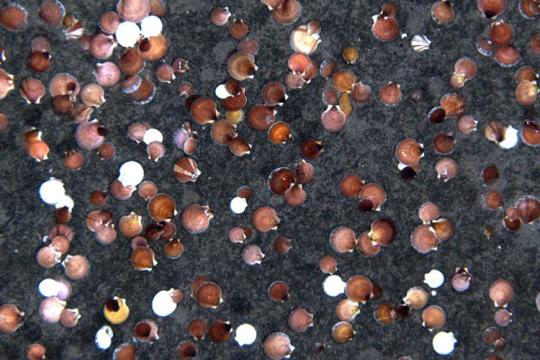When it comes to sustainable seafood and effective science-based fishery management, it takes a community of committed stakeholders and industry partners to make it happen. Scientists at the Northeast Fisheries Science Center and resource managers at our Greater Atlantic Regional Fisheries Office connect and work with commercial fishermen, seafood buyers and distributors, advocacy groups, and chefs. We work together to keep our region’s seafood sustainable, now and into the future.
It goes without saying—our region’s stakeholders and industry partners are an amazing fount of knowledge about local and regional seafood. When it comes to cooking it, they’ve got a few seriously useful tips about selecting, buying, storing, and cooking regional wild-caught seafood. In part one of this series, we asked seven industry members to share some of their best practices to help the home consumer. Whether you’re a cooking novice or an experienced seafoodie, there’s something here for everyone.
Jared Auerbach
Snapshot Bio
Jared is the founder and CEO for Red's Best in Boston, Massachusetts. Before that, he was a commercial fisherman in Alaska and on Cape Cod. He founded Red’s Best as a way for consumers to have direct access to fresh, sustainably-harvested seafood. They buy directly from local fishermen and farmers to supply the majority of the fish they sell in their market and eatery, and to local and regional restaurants.
Jared’s Seafood Tips
- Be flexible and have an open mind. Let the ocean and the seasons dictate what you eat.
- Don't be afraid of high-quality frozen fish if you can buy it directly from the offloader—a company that buys directly from fishermen.
- Have confidence that all seafood harvested in U.S. waters is caught in well-managed fisheries that harvest at a sustainable level that is set using the best available science.
Our Connection
Red’s Best buys fish from two of our Cooperative Research Branch’s industry partners, Eric Hesse and Doug Fenney. Eric is the owner and operator of F/V Tenacious II based out of East Dennis, Massachusetts, and often fishes in the Gulf of Maine. Doug is owner and operator of the F/V Noah based out of Chatham, Massachusetts. He fishes the waters just off Cape Cod and on George’s Bank. Eric’s been participating in our Gulf of Maine Cooperative Bottom Longline Survey since 2014. Doug’s been participating in our Study Fleet Program since 2016. You can read more about Doug in our web feature highlighting industry partners.
Tony Borges
Snapshot Bio
Tony is the owner and operator of the F/V Sao Paulo based out of New Bedford, Massachusetts. He fishes offshore, from the Gulf of Maine to Virginia, for groundfish, including haddock, winter flounder, witch flounder, summer flounder, monkfish, American lobster, skates, and longfin squid.
Tony’s Seafood Tips
- If you're battering and frying fish, you can’t beat halibut. In recipes calling for halibut, you can use fluke (summer flounder) as a substitute. It’s really the next best thing. The meat holds up well and it’s a good fish to cut into chunks or fillet.
- Monkfish is another one of my favorites. It's very easy to work with because it has no small bones to remove in the part we eat, just a spinal cord. That makes it a great fish for kids. They love it.
Our Connection
Tony has been participating in our Cooperative Research Branch’s Study Fleet Program since 2010. The fleet includes approximately 50 fishing vessels, whose captains and crews collect detailed data on fishing effort, catch, and environmental conditions. The data they collect have been used to:
- Estimate fishery footprints
- Develop catch-per-unit-effort indices for stock assessments
- Understand the potential impact of offshore wind on fishing operations
- Develop thermal niche models
- Inform regional oceanographic models
You can read more about Tony in our web feature highlighting industry partners.
Robert Colbert Jr.
Snapshot Bio
Robert is a commercial fishermen, dealer, co-director of Trebloc Seafoods Inc., and co-owner of Fishermen's View Market & Restaurant in Sandwich, Massachusetts. Fishermen's View is a sea-to-table seafood restaurant overlooking the Cape Cod Canal. Their eclectic menu ranges from Cape Cod classics to globally-inspired plates.
Robert’s Seafood Tips
Jonah Crab
- When looking to buy live Jonah crabs, make sure they’re really active, feisty.
- Keep Jonah crabs in your vegetable crisper at home for up to a day. You want them alive right up until cooking.
- Picking Jonah crabs can be a fun activity if you have a lot of time on your hands. However, if you don’t have a lot of time, you can buy it picked. Ours comes pasteurized and chilled as lump meat and as claw meat called “empress claws.” Buying processed Jonah crab means there are no special tools or storage needed.
- While I just love Jonah crab meat plain, or with a really tiny bit of mayo, on a toasted buttery roll, you can use it in all sorts of ways. You can make awesome crab cakes, cheesy dips, and cozy crab bisques; or fold it into mashed potatoes, add it on top of nachos, or use it as a stuffing for a more classic baked sole or haddock.
American Lobster
- Lobsters are a classic local seafood and really quite reasonably priced right now.
- Purchasing lobsters live and whole really helps support local fishermen during the pandemic.
- If you’re at a market, choose a hard-shell lobster and make sure it's active before taking it home.
- You can store lobsters in your vegetable crisper for a day until you are ready to cook them. Just as with whole live Jonah crabs, or any live shellfish, you want to also make sure the lobster is alive right until the moment you cook it
- We use meat from the knuckles in our "Knuckle Sandwich," a lobster avocado BLT sandwich. We also use it in baked mac and cheese, with melted cheese in a quesadilla, tossed into fried rice, and we even add it as a topping for a white sauce-based pizza! These are great ways to introduce kids to seafood because lobster goes so well as a topping on a lot of kid-friendly foods!
Sea Scallops
- Sea scallops are another crowd pleaser, and a good introduction to seafood. It’s a great local product.
- When you see them at the market they usually come shucked—just the muscular part of their body without their beautiful shells. Make sure they are dry, plump, and sweet-smelling. They should smell of the sea, but not “fishy.”
- My three favorite ways to cook scallops at home are: seared in a cast iron skillet with butter, salt and pepper; pan-fried with panko breadcrumbs; or baked in a casserole dish with butter and crumbled Ritz crackers on top.
- When cooking, make sure you cook them until they are just opaque and lose their slightly translucent quality.
- Sea scallops are really kid-friendly too. We used to cut them into smaller pieces and fry them with panko breadcrumbs for my daughters. It was a favorite meal, possibly because of the ketchup or tartar sauce they’d always dip them in.
Our Connection
Robert values the relationship between scientists and fishermen. He’s been involved in the Commercial Fisheries Research Foundation Lobster and Jonah Crab Research Fleet for 7 years. They bring data recording tools on their trips to record changes in bottom water temperatures, tools supplied by our Science Center staffer Jim Manning. Learn more about how our Science Center is supporting the Foundation's research fleet’s work.
Amanda Davis
Snapshot Bio
Amanda is the founder and executive director of Our Wicked Fish located in Western Massachusetts. She was disappointed that there were few resources about seafood seasonality, recipes, where to buy, and insights into our region’s fisheries. She also saw others wanting this kind of information and to connect with their local seafood options. In 2015, she decided to start Our Wicked Fish as a way to help get this kind of information to the masses. Their mission is to connect consumers and chefs in Western Massachusetts to local seafood through research and outreach. They want to generate a more sustainable and localized seafood industry in New England. They offer a variety of tools and resources to aid their mission. These include online recipes, where to buy seafood (restaurants, markets, and farmer’s markets), information about community and restaurant supported fishery programs, seafood season updates, and more.
Amanda’s Seafood Tips
- Always ask your fishmongers questions. They should know a lot about the fish they’re selling.
- Build a relationship with your fishmonger.
- Patronize smaller fish markets with knowledgeable and passionate staff. Be sure to talk to them every time you go in. They can tell you what was recently brought in, what is in season, and more.
- Many fishmongers and markets offer handling services for consumers. These include descaling, gutting, and filleting or other cuts of fish. Just ask. They’re more than happy to help their customers.
Our Connection
Amanda earned her master’s degree in September 2020 at the University of Massachusetts, Amherst. Her thesis was New England's Underutilized Seafood Species: Defining and Exploring Marketplace Potential in a Changing Climate. It looked at how local seafood was used by Boston area restaurants, and how young consumers experience lesser-known and underutilized seafood species. In her thesis, she used our Science Center’s stock assessment information. She’s also a huge supporter of FishWatch, which helps people make smart seafood choices, get up-to-date information about the status of U.S. fisheries, and understand how U.S. seafood is responsibly harvested and farmed.
Peter J. Fischbach
Snapshot Bio
Peter is the executive chef and food service consultant for Fischbach Food Service Consulting in Toms River, New Jersey. In 2009, he placed second in the NOAA-sponsored Great American Seafood Cook-off with his pan-seared Viking Village day-boat sea scallops with creamy chili-herb grits. Peter has always been an advocate for sourcing local, sustainable, and underutilized species. Working with NOAA Fisheries’ port agent Joanne Pellegrino has allowed him to amplify that passion.
Peter’s Seafood Tips
- Fish should smell fresh, sweet, salty, and mild, not “fishy” or like ammonia.
- Fresh fish should have firm and elastic flesh. Test it by pressing the flesh delicately with your finger. It should spring back.
- Shiny skin and scales that adhere tightly is another indicator of freshness.
- The eyes of fresh fish should be clear, bright, and a little protruding. Cloudy, pink and sunken eyes indicate the fish has lost its freshness.
- The gills should be bright red or pink and free from slime.
- Pre-packaged fillets should contain a minimum of liquid because when it’s stored in liquid, it deteriorates quickly.
- Finfish should be stored in the refrigerator and used within 1 to 2 days after purchase. It’s a good idea to store it on ice in the refrigerator to keep it as cold as possible.
- If you plan on grilling or barbecuing fish, it is much easier to work with if it is cut into steaks.
- Keep leftover flesh for smaller kid-sized steaks, or to use in fish stock.
Our Connection
Peter met port agent Joanne Pellegrino a decade or more ago when the Viking Village started their summer dock tours. Joanne does outreach at these events. Peter does cooking demonstrations with the fresh, local seafood that commercial fishermen sell to Viking Village, Inc., a commercial seafood buyer/seller in Barnegat Bay, New Jersey. Learn more about Viking Village, its dock tours, and see interviews with Peter and Joanne in this video.
Peter buys his seafood directly from Viking Village. Four of our Study Fleet Program vessels supply Viking Village, including the F/V Dana Christine II which is owned and operated by Kevin Wark. Kevin Wark has been participating in our Study Fleet Program since 2012. You can read more about Kevin in our web feature highlighting industry partners.
Peter has also worked with Doug Zemeckis, a marine extension agent for Rutgers’ Department of Agriculture and Natural Resources. Doug helped our Cooperative Research Branch coordinate their 2019 Stakeholder Engagement Session in Toms River, New Jersey.
Recently, Peter shared a few of his sustainable seafood recipes that you can find on FishWatch. If you like black sea bass, be sure to check out his recipe for crispy black sea bass with warm asparagus and pickled red onion salad. If you’re looking for a great soft taco recipe, check out his spiny dogfish tacos dressed with avocado, onion, and cabbage drizzled with a cilantro-lime yogurt crema. Yum!
Kate Masury
Snapshot Bio
Kate is the program director at Eating with the Ecosystem. Her work includes organizing and running educational and outreach events, conducting research, building relationships with chefs, fishermen, scientists, seafood businesses, and citizen scientists. Eating with the Ecosystem promotes a place-based approach to sustaining New England’s wild seafood, through flourishing food webs, healthy habitats, and short, adaptive seafood supply chains.
Kate’s Seafood Tips
- When selecting and buying fish, be flexible. While many recipes call for a specific fish species, other species with similar texture and/or flavor can be substituted.
- Seafood is a perfect weeknight meal because it’s quick and easy. Most of the fish in our region cook faster than most cuts of land-based meats. With fish you’re done in 15 minutes. It’s simple and healthy.
- Eating with the Ecosystem has many more seafood tips and local seafood resources.
Our Connection
Eating with the Ecosystem's Advisory Network consists of fishermen, chefs, supply chain businesses, scientists, and other experts. Science Center scientist Mike Fogarty is a member of this network. Commercial fishermen Al Eagles, Doug Fenney, and Rodman Sykes are also members. Al is the captain of the F/V Catherine Ann based out of Newport, Rhode Island. He participates in the Lobster and Jonah Crab Research Fleet, organized by the Commercial Fisheries Research Foundation. We provided funding to the Atlantic States Marine Fisheries Commission to support the research fleet’s work installing temperature sensors on lobster traps. Doug is the owner and operator of the F/V Noah based out of Chatham, Massachusetts. He has been participating in our Study Fleet Program since 2016. Rodman is the owner and operator of the F/V Virginia Marise based out of Point Judith, Rhode Island, and has been participating in the program since 2008.
Eating with the Ecosystem shares NOAA Fisheries' mission of promoting sustainable U.S. seafood by focusing on underutilized fisheries.
Ethan Wood
Snapshot Bio
Ethan is owner of Wood Mountain Fish in Boston, Massachusetts, which he started in 2004. He specializes in purchasing fish directly from fishermen and selling exclusively to high-end restaurants and grocers in Vermont. Vermonters take their food very seriously and want to know exactly where it’s coming from. He has spent years developing relationships with the fishermen in order to provide those details. He wants to be a good steward to our shared natural resources and strives to be responsible by focusing on fish that are sustainably harvested. He’s even started to promote a few species of underutilized fish and cuts of fish to his customers. These include skates, monkfish livers, and fish cheeks from skates, monkfish, and halibut. Since COVID-19, he has shifted more toward retail sales.
Ethan’s Seafood Tips
- Often the average consumer wants Atlantic cod and haddock, which can be expensive because these fish are in high demand. Fortunately, there are other local and regional fish that are great substitutes. They have that flaky texture that chefs want, are cheaper, and can be fresher because the fish were landed locally.
- Often Atlantic cod and haddock are used to make fish and chips. However, you can make fish and chips with other kinds of fish, including skate (wings and cheeks), monkfish (cheeks), cusk, pollock, and hake. These high-quality fish and cuts of fish often cost less too.
- Eat the fish that other fish eat—fish species that are lower in the food web. Eating fish like whiting, herring, and mackerel that are lower in the food web is often more sustainable. Also, these fish have healthy oils like Omega 3s—there’s a reason other fish eat them. Plus, you can cure, can, and smoke these fish.
- Try new or unfamiliar fish like mackerel and scup.
- Have a plan when buying a whole fish. Think of ways to use all parts of your fish. For example, after filleting your fish, consider freezing the remaining parts. After a couple of purchases, you’ll have enough to make a really nice fish stock.
Our Connection
Ethan sources a lot of his fish from Red’s Best. Red’s Best buys their fish from two of our Cooperative Research Branch’s industry partners, Eric Hesse and Doug Fenney. Eric is the owner and operator of F/V Tenacious II based out of East Dennis, Massachusetts, and mostly fishes in the Gulf of Maine. Doug is owner and operator of the F/V Noah based out of Chatham, Massachusetts, and fishes the waters just off Cape Cod and on George’s Bank. Eric has participated in our Gulf of Maine Cooperative Bottom Longline Survey since 2014 and Doug has participated in our Study Fleet Program since 2016. You can read more about Doug in our web feature highlighting industry partners.
For more information, please contact Heather Soulen or Giovanni Gianesin.
